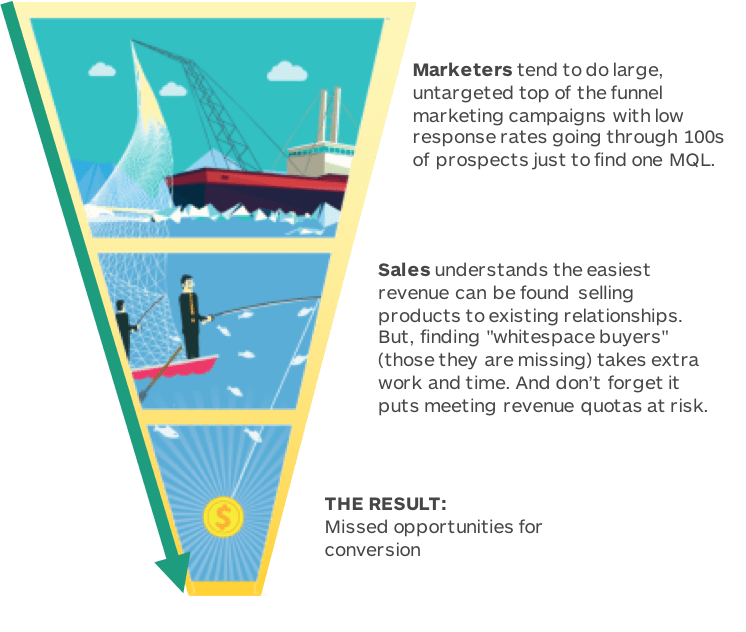Marketers – You’re Doing it All Wrong. How to Chop the Funnel in Half + Gain ROI.
In the past, my team and our clients have spent a lot of time, energy, and budget at the top of the funnel. Whether it be creating valuable content, writing clever emails, delivering webinars, or attending large tradeshows/events – we all have our “fingers crossed” that we can generate demand and handoff MQLs to our sales team. And as part of our optimization strategy, we pour over marketing reports and dashboards to make data-based decisions on where to invest next.
But the question always remains, what is ACTUALLY going to lead to ROI?
An alarming 80% of marketers report that their lead generation efforts are only slightly or somewhat effective. We’ve pondered through the many reasons around why our process might be faulty – is it the lead qualification system, the way in which we nurture buyers, or frankly are they JUST NOT READY to buy?
Having had the privilege of working in client facing roles – Customer Success, Professional Services, Sales Enablement – I’ve learned that the needs of each customer are SO vastly different, detailed and unique that there is virtually no way one marketing message could cover the majority of your target audience’s pain points or needs. Trust me – there is NO holy grail marketing message that will bring in the big bucks (at least for B2B).
What if we, as marketers, are casting our net TOO wide?
By looking at the top of the funnel, aka the “let’s go after all possible fish in the sea” way, we could be setting ourselves up for imminent failure. Instead, how can we be more proactive on who to target –starting with leveraging valuable internal and external data to identify the right targets FIRST, then delivering them the right message, content, and product. It’s an almost backwards approach to traditional marketing. But focusing more in the middle of the funnel (known leads, backed by data) and less on generating net new leads, is a better place to spend time. Buyers are already hit with a million and one marketing messages, so why swim circles at the top when you could fast track to the middle?
What do we mean by “the middle?” Where do you start?
One thing is for sure, whether you’re in marketing or sales, we’re all after the same thing – more revenue for the business. Most product marketing teams are aligned on that goal – increasing revenue for a specific product, plus running marketing campaigns to do so. But are your campaigns aligned to sales plays? What I mean by sales plays – sales teams and their reps have specific, set in place motions, messaging and pitches to targeted sets of buyers on a weekly basis. Sounds JUST like a marketing campaign right? Maybe, but sales campaigns are a bit more than detailed marketing campaigns…
Let’s explore the sales play concept a bit more specifically. Let’s say your sales team is running a cross-sell play of Product B to customers with Product A. To run this play, the sales rep would gather crucial data including an install base report, transactional data, orders, support data, overall account health etc. and go after the list of accounts in a very targeted manner. These very specific data signals are critical to understanding how to go after accounts. However, finding this data takes time. Sales reps spend 17 minutes performing pre-outreach research before picking up the phone or sending out a single email. This is the starting point for better marketing – no longer focusing the majority of your time at the top of the funnel but instead, the middle – the intersection of product and buyer signals for which you can help sales with a much more qualified handoff. When marketing’s new starting point is in the “whitespace,” this can reduce research time while pinpointing BETTER, more likely buyers (MQLS).
Use Case: By leveraging the internal data behind Product A, (install base, product usage tickets, support tickets, and other internal data) marketing can find leads that might not be covered by sales (what we call “whitespace”) but are a high product fit. This would be the ideal target list. Then, send targeted outreach (either through marketing or the sales team) to promote Product B’s positioning and value proposition.
In this way, marketing is not only generating MQLs, but taking it a step further.
I call it “MQO’s” – Marketing Qualified Opportunities. Marketing is more successful in generating qualified leads by using all of the various data points available and finding prime leads that already exist. Then, packaging them up for sales – providing the most ideal messaging, content, call to action and putting it right into sales hands. And now, sales can do what they do best, close the deal. I believe if marketing campaigns and sales plays are aligned in this way, you can cut the entire funnel by almost half, and we are noticing that right here at MarketBridge and with our clients.
What are your thoughts on “MQOs?” Does your team have a similar process?







